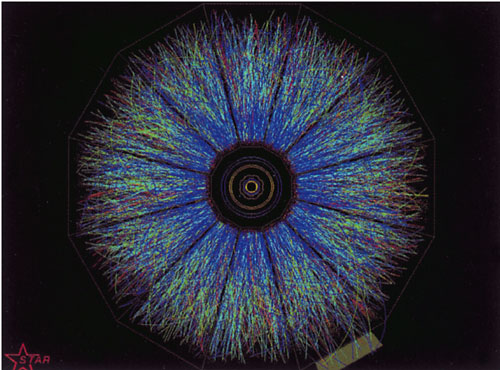
This Article From Issue
March-April 2009
Volume 97, Number 2
Page 165
DOI: 10.1511/2009.77.165
THE LIGHTNESS OF BEING: Mass, Ether, and the Unification of Forces. Frank Wilczek. xii + 270 pp. Basic Books, 2008. $26.95.
On September 10 of last year, physicists at CERN (the European Organization for Nuclear Research in Geneva) for the very first time steered protons around the Large Hadron Collider (LHC), a truly gargantuan subatomic microscope with equally grand and ambitious physics goals. The LHC (now undergoing repairs) is the world’s most powerful particle accelerator. It includes more than 1,600 superconducting magnets, used to bend and focus protons into a circular path, and 16 radiofrequency cavities, used to accelerate those protons. All this is housed in a tunnel whose circumference is 27 kilometers (17 miles), which is buried at an average depth of 100 meters on the border between France and Switzerland. The LHC has two counter-circulating proton beams—each with the energy of 7 trillion electron volts—which will be brought together at several points along the LHC tunnel, where large detectors will observe the remnants of the resulting collisions.

From The Lightness of Being.
One of those particle detectors, named ATLAS, has a volume of about 23,000 cubic meters, weighs 7,000 metric tons, cost about 540 million Swiss francs and was built by a collaboration of 2,500 physicists, engineers and students from 169 institutions in 37 countries. Each second, ATLAS will electronically sort through one billion collisions to select a few hundred potentially interesting events for further analysis. This process will generate about 3 petabytes (3 million gigabytes) of recorded data each year, which are to be analyzed by an international team of hundreds of physicists utilizing thousands of computers communicating through the World Wide Web.
The goal of ATLAS and the other LHC detectors is to provide data that will help answer some profound questions of physics. What is the origin of ordinary mass? Why are some elementary particles heavy, whereas others are light?
The answers will likely involve the Higgs mechanism, which predicts a new field, analogous to the electromagnetic field. This field should have at least one particle associated with it: the Higgs particle (which Peter Higgs postulated in 1964 and which Nobel laureate Leon Lederman famously dubbed the “God particle”). One goal of LHC experiments is to find the Higgs particle. Scientists are split on whether this is likely to happen, though. Higgs recently locked horns with Stephen Hawking, who has bet $100 that the Higgs won’t be found.
Another goal of physics is to construct a theory that unifies all the fundamental forces, including gravity. If supersymmetric particles (massive relatives of the particles we now know about) are discovered at the LHC, this grand unification may be facilitated.
Astrophysical observations now indicate that all of the visible matter, or normal matter, accounts for only 4 to 5 percent of the mass in the universe. The 95 percent that is missing is thought to be in the form of dark matter or dark energy. LHC experiments will search for new particles or phenomena that could be responsible for this missing matter and energy.
This is all heavy stuff. A new book by Frank Wilczek, The Lightness of Being, does a superb job of introducing the reader to the aforementioned profound questions and to our current understanding of the nature of matter and the forces that govern the universe.
Wilczek played a critical role in developing the theory of quantum chromodynamics (QCD), which describes the strong interaction, a fundamental force of nature that acts to hold the nucleus together. For work he did as a 21-year-old graduate student, he shared the 2004 Nobel Prize in Physics with his Ph.D. mentor, David Gross (a professor at the University of California, Santa Barbara, and director of the Kavli Institute of Theoretical Physics), and with David Politzer (a professor at the California Institute of Technology).
The Nobel Foundation Web site (http://nobelprize.org) offers much background information on Wilczek, his prize-winning colleagues and their work, along with a video of an interview of Wilczek and Gross by Joanna Rose, a science writer. The two men share with Rose their thoughts about their theoretical discovery, the experimental work confirming it, and the importance of asking the right questions. What makes this video so delightful is the “lightness of being”—playfulness, even—that Wilczek and Gross exhibit in describing their work.
Wilczek also displays a “lightness of touch” in this book, as Frank Close notes in a blurb on the dust jacket. Wilczek takes a historical approach, beginning with what he characterizes as the “beta release” of the quark model, which Murray Gell-Mann and George Zweig postulated independently in 1964, bringing into some order the dozens of hadrons that had been discovered by that point.
Hadrons are particles made up of quarks and gluons. The subclasses of hadrons are baryons (a family that includes the proton and the neutron) and mesons. Baryons are made of three quarks, whereas mesons consist of a quark and an antiquark. The quark model did for hadrons what the atomic theory of electrons and nuclei did for the myriad of atoms in the periodic table.
In the 1970s, quantum chromodynamics took shape. QCD is modeled somewhat after the theory of quantum electrodynamics (QED), which brings together electrodynamics, quantum mechanics and special relativity in describing the interaction of electrically charged particles. However, there are important differences between QED and QCD. The force between electrically charged particles falls off with the square of the distance between them. That’s why we can pull an electron away from its host atom. But the same is not true of quarks. If you try to remove a quark from its hadronic host, the force between that quark and its partners does not decrease, so infinite energy would be required to pull it away. Free electrons exist, but quarks cannot be isolated.
To account for this experimental fact, QCD contains the principle of confinement: When quarks are very close to one another, they move about freely, not feeling one another’s influence. This feature of QCD is called asymptotic freedom.
QED describes the opposite sort of behavior. The underlying reason that the force from an electrically charged particle decreases with distance is the temporary existence of the many electron-positron pairs that spontaneously pop out of the vacuum. These pairs serve to screen the electric charge of the particle, which thus exerts a large force on a second charged particle only when it is positioned close by. The first particle becomes increasingly ineffectual when the second one is located far away.
In QCD, instead of screening there is an antiscreening, not of electrical charge, but of its analog, the color charge—which is in no way related to what we normally think of as color. The color charge is responsible for the strong force between quarks and gluons. Wilczek tells the story of how he and David Gross discovered this feature of QCD in 1973.
Wilczek also gives an account of the Nobel-prize experiments, the interpretation of which led him and Gross to their discovery. As Wilczek describes the “ultrastrobonanomicroworld” (his word!) of quarks and gluons inside the proton, he notes that
Our eyes were not designed (ahem, did not evolve) to resolve such small distances and times, so any visual representation [of this world] must be a mixture of caricature, metaphor, and cheat.
It is writing like this, and there are many other examples, that makes this book so much fun to read.
Wilczek tackles such grand issues as the role of symmetry in physics, the nature of the vacuum, the origin of mass, grand unification, supersymmetry, dark matter and dark energy. His touch is indeed light: There are only a few equations. However, not every chapter is an easy read; some may have to be revisited a few times. The book also includes a very useful glossary, 16 pages of endnotes and three brief appendices.
The Lightness of Being is a wonderful program guide to what we can expect from the LHC in the coming years. Stay tuned.
Alex R. Dzierba is Chancellor’s Professor Emeritus of Physics at Indiana University in Bloomington. He has served as scientific leader of a number of collaborations of physicists at Fermi National Accelerator Laboratory, Brookhaven National Laboratory and Thomas Jefferson National Accelerator Facility. He received a doctorate in experimental particle physics from the University of Notre Dame in 1969. Address: Department of Physics, Indiana University, Swain West 117, 727 E. 3rd Street, Bloomington, IN 47405-7105. Internet: dzierba at indiana dot edu

American Scientist Comments and Discussion
To discuss our articles or comment on them, please share them and tag American Scientist on social media platforms. Here are links to our profiles on Twitter, Facebook, and LinkedIn.
If we re-share your post, we will moderate comments/discussion following our comments policy.